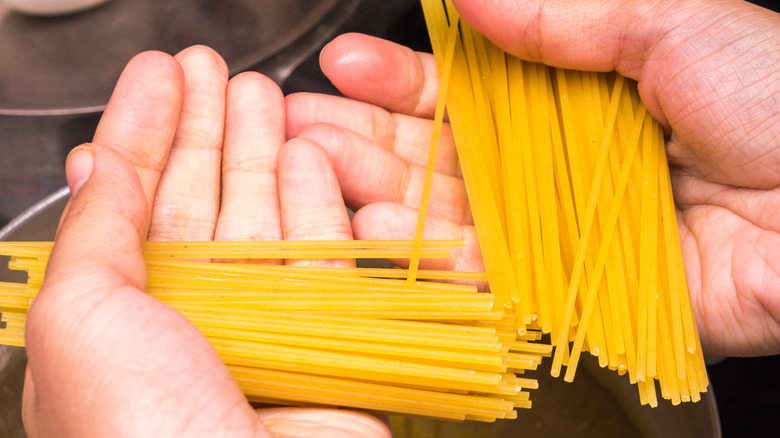Why Many Italian Chefs Would Never Break Spaghetti
If you're cooking for Italians (especially a chef), one surefire way to break their hearts is to snap spaghetti in half before cooking it. In Italian culinary culture, breaking spaghetti is broadly considered a no-no, predominantly for cultural reasons.
In Italy, spaghetti is seen as a food that should be served whole, long, and skinny, with a clear rationale behind this tradition. This is because spaghetti is meant to be twirled around a fork in a way that also gathers up sauce. With shorter, snapped-in-half pieces of spaghetti, this twirling becomes more difficult or impossible: The spaghetti may be too short to twirl, or the sauce might weigh it down, causing it to fall off the fork. Therefore, it's imperative to keep spaghetti strands at their full length, which is around 10 inches (although they used to be much longer). The same principle applies to other long forms of pasta, such as fettuccine. However, this is not a concern with fresh pasta, as it is soft, pliable, and ideally cannot be snapped.
Other reasons not to break spaghetti
Although the primary reason for not breaking spaghetti is to ensure it can be neatly twirled on a fork, there are a few additional theories about why you shouldn't break it. One theory suggests that breaking spaghetti is simply bad etiquette, though this is really just an extension of the main reason — spaghetti is meant to be eaten whole, so breaking it could be perceived as rude (similarly, it's also considered rude to cut spaghetti with a knife, for mostly the same reasons).
The other justifications for not breaking spaghetti are more nebulous. Some superstitious individuals may believe it brings bad luck, though the exact reasoning for this belief is unclear (as is the case with many superstitions, like the fear of walking under a ladder). There are even rumors that breaking spaghetti is illegal in Italy. While it might be poor etiquette to snap spaghetti, this claim is entirely false.
The one situation when you can snap spaghetti
Italian cooks make one exception for when breaking spaghetti is acceptable. But first, let's dismiss one common justification for breaking spaghetti. Even if the spaghetti is so long that it pokes out of the pot when you try to cook it, you still shouldn't break it. Some people rationalize breaking it by suggesting that broken spaghetti will cook more evenly — arguing that with full-length spaghetti, the ends may spend a few seconds outside the boiling water. Italian cooks don't buy this excuse. Instead, it's better to just use a bigger pot, or push the spaghetti down into the pot once the ends submerged in the water have softened.
The one time an Italian cook might break spaghetti is when using it in a soup, such as minestrone, or in certain stews like pasta e fagioli. This practice might not be universally accepted; the general rule is to use smaller pasta shapes in soup. Therefore, some Italian chefs might only begrudgingly accept breaking spaghetti for these dishes, but it is less likely to upset them than breaking spaghetti for dishes like cacio e pepe.


